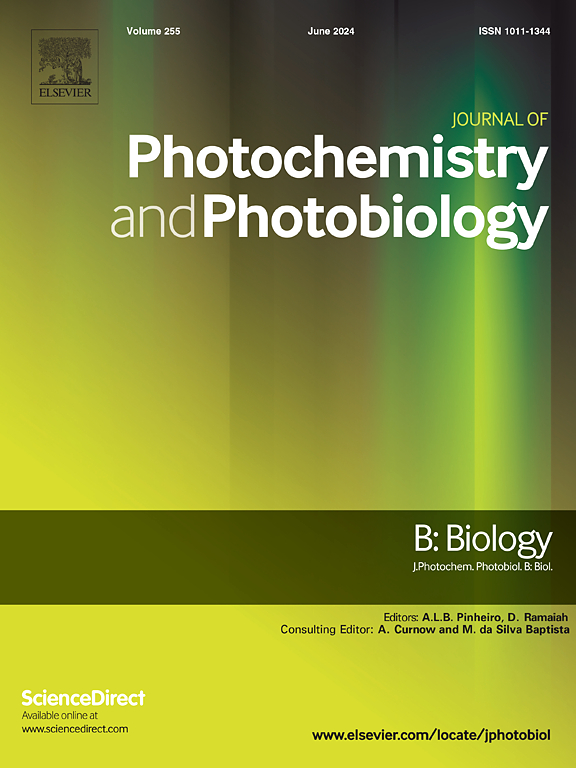Neodymium-doped yttrium vanadate laser and Phthalocyanine photosensitizer doped chitosan nanoparticle activated via Photodynamic therapy on smear layer and push-out bond strength of fiber post: An in vitro SEM, EDX assessment
IF 3.7
2区 生物学
Q2 BIOCHEMISTRY & MOLECULAR BIOLOGY
Journal of photochemistry and photobiology. B, Biology
Pub Date : 2025-09-10
DOI:10.1016/j.jphotobiol.2025.113263
引用次数: 0
Abstract
Aims
To quantify the effectiveness of different root canal sterilants, i.e., Sodium Hypochlorite (NaOCl), Neodymium-doped Yttrium Vanadate (Nd: YVO4) laser, Phthalocyanine photosensitizer doped Chitosan nanoparticles activated via Photodynamic therapy (Pc-CNPs-PDT), on smear layer (SL) elimination and push out bond strength (PBS) of glass fiber posts (GFPs) bonded to root dentin.
Materials and methods
Forty-eight human premolars with an approximate root length measuring 15 ± 1 mm were included. Endodontic treatment was performed using a nickel‑titanium rotary instrument followed by obturation. The post space was prepared, and specimens were allocated to four groups based on the disinfection protocol employed. Group 1 (Saline + EDTA), Group 2 (2.25 % NaOCl + EDTA), Group 3 (Nd: YVO4 laser + EDTA), Group 4 (Pc-CNPs-PDT + EDTA). A scanning electron microscope was used to assess the surface topography of CHNPs, energy-dispersive spectroscopy (EDS), and SL removal efficacy. Each post was luted using a dual-cure resin cement. The bonded specimens were sectioned into slices (coronal, middle, and apical). A universal testing machine and a stereomicroscope were used to test the PBS and failure modes, respectively. The dataset underwent analysis through one-way analysis of variance ANOVA and Tukey's test to determine notable differences among groups (p = 0.05).
Results
Coronal section of Group 4 (Pc (CHNPs)-PDT + EDTA) samples exhibited maximum SL removal. Whereas, minimum SL elimination was displayed by Saline pretreated canals at the apical section. Samples irrigated with 2.5 % NaOCl + EDTA and Pc (CHNPs)-PDT + EDTA presented comparable scores of bond integrity at all three root sections.
Conclusion
Phthalocyanine photosensitizer doped Chitosan nanoparticles, activated via Photodynamic therapy, can be considered as a suitable alternative to the gold standard technique, NaOCl and EDTA, in removing smear layer and improving glass fiber post adhesion to canal dentin.
掺钕钒酸钇激光和酞菁光敏剂掺杂壳聚糖纳米粒子光动力活化对纤维桩涂抹层和推出粘结强度的影响:体外SEM, EDX评价
目的研究次氯酸钠(NaOCl)、掺钕钒酸钇(Nd: YVO4)激光、光动力疗法激活的酞青素光敏剂掺杂壳聚糖纳米颗粒(Pc-CNPs-PDT)等不同根管灭菌剂对玻璃纤维桩(gfp)黏结在根本质上的涂片层(SL)消除和推出粘结强度(PBS)的影响。材料与方法48颗人前磨牙,根长约为15±1 mm。采用镍钛旋转器械进行根管治疗,随后进行封闭。准备岗哨,按消毒方案将标本分为4组。1组(生理盐水+ EDTA)、2组(2.25% NaOCl + EDTA)、3组(Nd: YVO4激光+ EDTA)、4组(Pc-CNPs-PDT + EDTA)。采用扫描电镜对CHNPs的表面形貌、能谱分析(EDS)和SL去除效果进行了评价。每个桩使用双固化树脂水泥。将粘接标本切片(冠状、中、尖)。用万能试验机和体视显微镜分别对PBS和失效模式进行了测试。对数据集进行单因素方差分析和Tukey检验,各组间差异有统计学意义(p = 0.05)。结果第4组(Pc (CHNPs)-PDT + EDTA)样品的横切面显示出最大的SL去除。然而,经盐水预处理的根管在根尖部分显示出最小的SL消除。用2.5% NaOCl + EDTA和Pc (CHNPs)-PDT + EDTA灌溉的样品在所有三个根段的键完整性得分相当。结论经光动力活化的酞菁光敏剂掺杂壳聚糖纳米颗粒可作为金标准技术NaOCl和EDTA的替代材料,去除涂膜层,改善玻璃纤维桩与根管牙本质的粘附。
本文章由计算机程序翻译,如有差异,请以英文原文为准。
求助全文
约1分钟内获得全文
求助全文
来源期刊
CiteScore
12.10
自引率
1.90%
发文量
161
审稿时长
37 days
期刊介绍:
The Journal of Photochemistry and Photobiology B: Biology provides a forum for the publication of papers relating to the various aspects of photobiology, as well as a means for communication in this multidisciplinary field.
The scope includes:
- Bioluminescence
- Chronobiology
- DNA repair
- Environmental photobiology
- Nanotechnology in photobiology
- Photocarcinogenesis
- Photochemistry of biomolecules
- Photodynamic therapy
- Photomedicine
- Photomorphogenesis
- Photomovement
- Photoreception
- Photosensitization
- Photosynthesis
- Phototechnology
- Spectroscopy of biological systems
- UV and visible radiation effects and vision.

 求助内容:
求助内容: 应助结果提醒方式:
应助结果提醒方式:


